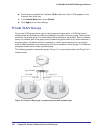
Chapter 25. Spanning Tree Protocol | 408
25
25. Spanning Tree Protocol
This chapter provides the following examples:
• Configure Classic STP (802.1d)
• Configure Rapid STP (802.1w) on page 410
• Configure Multiple STP (802.1s) on page 411
The purpose of Spanning Tree is to eliminate loops in the switch system. There are three
STPs: Classic STP (802.1d), Rapid STP (RSTP
, 802.1w), and Multiple STP (MSTP, 802.1s).
While STP can take 30 to 50 seconds to respond to a topology change, RSTP is typically
able to respond to changes within a few seconds. RSTP can revert back to 802.1d in order to
interoperate with legacy bridges on a per-port basis. This drops the benefits it introduces.
In Multiple Spanning Tree Protocol (MSTP), each Spanning Tree instance can contain
several VLANs. Each Spanning
Tree instance is independent of other instances. This
approach provides multiple forwarding paths for data traffic, enabling load balancing, and
reducing the number of Spanning Tree instances required to support a large number of
VLANs.
Configure Classic STP (802.1d)
The example is shown as CLI commands and as a Web interface procedure.
CLI: Configure Classic STP (802.1d)
(Netgear Switch) (Config)# spanning-tree
(Netgear Switch) (Config)# spanning-tree forceversion 802.1d
(Netgear switch) (Interface 1/0/3)# spanning-tree port mode


















